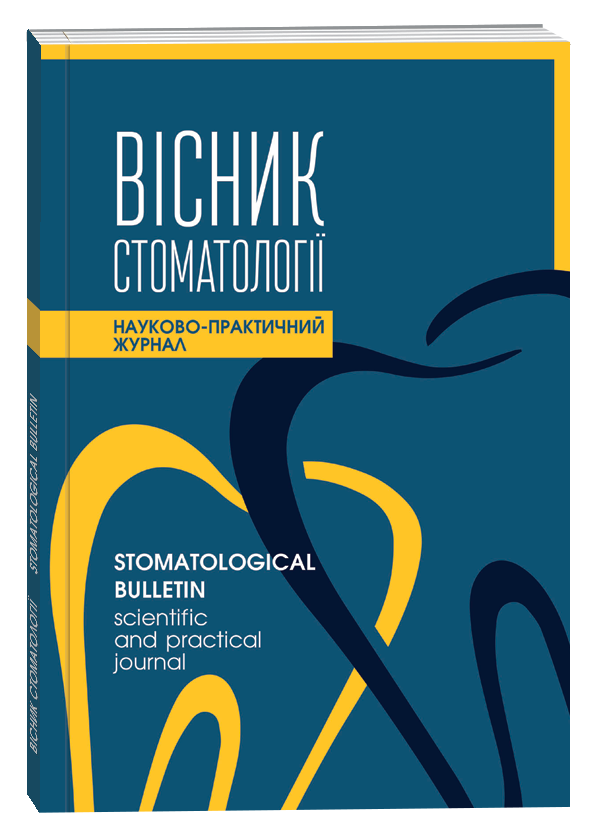FEATURES OF CONDUCTING AND CLINICAL EVALUATION OF DIRECT PHOTOCOMPOSITION RECONSTRUCTIONS OF LATERAL TEETH
DOI:
https://doi.org/10.35220/2078-8916-2020-38-4-31-35Keywords:
lateral teeth, cavities, enamel Bevel, direct restoration, photocomposite, clinical evaluationAbstract
For direct restoration of teeth from photocomposites, cav-ities are prepared in accordance with a number of re-quirements.
Purpose of the work. Comparative assessment of the clin-ical condition of direct restoration of lateral teeth from photocomposition materials made with different for-mation of cavities and enamel edges.
Materials and methods. We examined 157 patients who performed 157 direct photocomposition reconstructions on the chewing surfaces of the lateral teeth for uncompli-cated caries. In patients of Group 1, cavities in 47 teeth (29.9 %) were prepared with steep walls, in individuals of Group 2, cavities in 52 teeth (33.1 %) were formed with a bevel of enamel, in patients of Group 3, cavities in 58 teeth (37 %) were prepared with overhanging edges, and the bevel was created after strengthening the enamel with a photocomposite. Recovery was evaluated at 6 and 12 months according to a number of criteria, including using a dental microscope.
Research results. After 6 months, the worst indicators were obtained in people of Group 1, in total, there were 14 violations in 10 recoveries (21.3 %). Group 2 patients had 5 abnormalities in 3 recoveries (5.8 %), and Group 3 patients had 3 defects in 1 recoveries (1.7 %). At 12 months, people of Group 1 were found to have 17 viola-tions in 9 recoveries (24.3 %), Group 2 – 12 violations in 6 recoveries (12.2 %), Group 3 – 7 violations in recover-ies (5.3 %). There were, respectively, 28 restorations without violations during this period(59,6 %), 43 (82,7 %) and 54 recoveries (93.1 %).
Conclusion. By creating a bevel of the edges of the enam-el reinforced with photocomposite, a high efficiency of re-storing the side teeth is achieved.
References
Kassebaum J. Global burden of untreated caries: a systematic review and metaregression / J. Kassebaum, E. Bernabe, M. Dahiya // J. Dent. Res. – 2015. – №94(5). – Р. 650-658.
Чухрай И. Г. Ошибки и осложнения, возникаю-щие при изготовлении реставраций из композиционных ма-териалов / И. Г. Чухрай, Н. В. Новак, Е. И. Марченко // Сов-ременная стоматология. – 2014. - №1. – С. 20-25.
Усевич Т. Л. Клиническое материаловедение в стоматологии / Т. Л. Усевич. – М.: Феникс, 2015. – С. 320.
Николаев А. И. Практическая терапевтическая стоматология: учеб. пособие / А. И. Николаев, Л. М. Цепов. – [9-е изд.] – М.: МЕДпресс-информ, 2017. – С. 928.
Удод О. А. Удосконалені підходи до прямого від-новлення зубів фотокомпозитами / О. А. Удод, О. Б. Роман // Colloquium-journal. – 2020. – №20(72). – С. 40-44.
Михальченко А. В. Сравнительная эффектив-ность свойств современных композиционных материалов / А. В Михальченко, С. В. Дьяченко, Д. Ю. Дьяченко // Вол-гоградский научно-медицинский журнал. – 2018. – №4. – С. 36-43.
Жукова Е. С. Сравнительная оценка краевого прилегания композиционных пломбировочных материалов при различной адгезивной подготовке твердых тканей зуба / Е. С. Жукова, С. И. Токмакова, О. В. Бондаренко // Медико-фармацевтический журнал «Пульс». – 2017. – №10(19). – С. 181-183.
Лахтін Ю. В. Клінічна оцінка реставрацій при різ-ному дизайні емалевого краю каріозних порожнин 1 класу за Блеком / Ю. В. Лахтін, Ю. В. Сміянов // Вісник проблем біології і медицини. – 2019. – №1(148). – С. 335-339.
Шидакова А. У. Использование операционного микроскопа при проведении эстетической реставрации зу-бов / А. У. Шидакова, К. М. Хохлова, А. С. Зотова // Бюлле-тень медицинских интернет-конференций. – 2017. – №11. – С. 1620.









